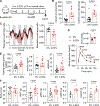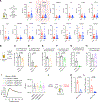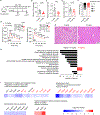A small intestinal bile acid modulates the gut microbiome to improve host metabolic phenotypes following bariatric surgery
- PMID: 39043190
- PMCID: PMC11332993
- DOI: 10.1016/j.chom.2024.06.014
A small intestinal bile acid modulates the gut microbiome to improve host metabolic phenotypes following bariatric surgery
Abstract
Bariatric surgical procedures such as sleeve gastrectomy (SG) provide effective type 2 diabetes (T2D) remission in human patients. Previous work demonstrated that gastrointestinal levels of the bacterial metabolite lithocholic acid (LCA) are decreased after SG in mice and humans. Here, we show that LCA worsens glucose tolerance and impairs whole-body metabolism. We also show that taurodeoxycholic acid (TDCA), which is the only bile acid whose concentration increases in the murine small intestine post-SG, suppresses the bacterial bile acid-inducible (bai) operon and production of LCA both in vitro and in vivo. Treatment of diet-induced obese mice with TDCA reduces LCA levels and leads to microbiome-dependent improvements in glucose handling. Moreover, TDCA abundance is decreased in small intestinal tissue from T2D patients. This work reveals that TDCA is an endogenous inhibitor of LCA production and suggests that TDCA may contribute to the glucoregulatory effects of bariatric surgery.
Keywords: bariatric surgery; bile acid-inducible operon; bile acids; lithocholic acid; metabolism; small intestine; taurodeoxycholic acid; type 2 diabetes.
Copyright © 2024 Elsevier Inc. All rights reserved.
Conflict of interest statement
Declaration of interests S.N.C., D.A.H., E.G.S., and A.S.D. are co-inventors on patents related to this work. A.S.D. is an ad hoc consultant for Axial Therapeutics. S.N.C. is an ad hoc consultant for Metis Therapeutics. E.G.S. is an ad hoc consultant for Vicarious Surgical, Inc. and has educational support/speaker fees from Cine-Med and Intuitive Surgical, Inc. A.T. is a cofounder and consultant for AltrixBio.
Figures







References
-
- Cho N, Kirigia J, Ogurstova K, Reja A. IDF Diabetes Atlas, tenth edition. Published online 2017:1–150. Accessed July 25, 2023. https://www.mendeley.com/catalogue/f3c67578-c2bc-3d94-8dc5-450b49fe6102/...
-
- Eisenberg D, Shikora SA, Aarts E, et al. 2022 American Society of Metabolic and Bariatric Surgery (ASMBS) and International Federation for the Surgery of Obesity and Metabolic Disorders (IFSO) Indications for Metabolic and Bariatric Surgery. Obes Surg 2022 331. 2022;33(1):3–14. doi: 10.1007/S11695-022-06332-1 - DOI - PMC - PubMed
MeSH terms
Substances
Grants and funding
LinkOut - more resources
Full Text Sources
Medical
Molecular Biology Databases
Research Materials

